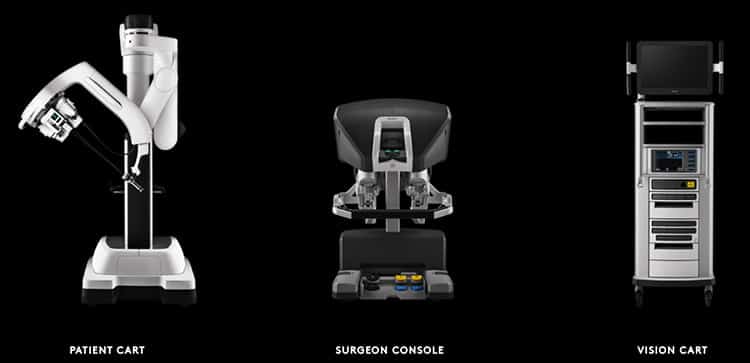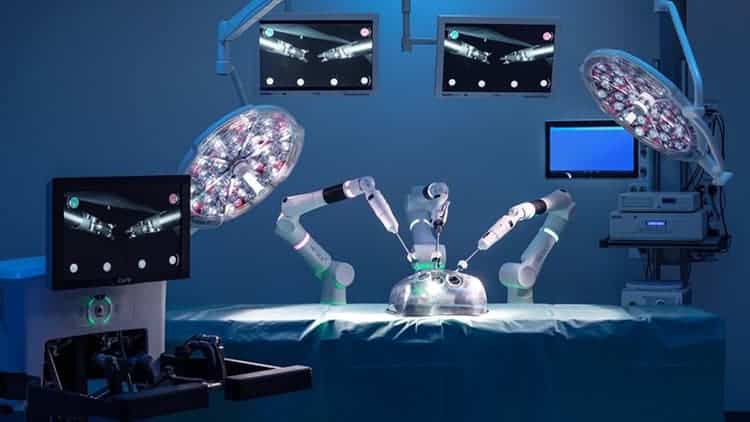CMR Surgical Deploys Its Surgical Robotic System Versius
Table of contents

In this day and age where we’ve turned over initial medical diagnoses to artificially intelligent bots, it’s hard to imagine a time when technology did not play a central role in healthcare. Yet leeches were still considered high-tech as recently as the 19th century – and are making something of a comeback today in some surgical circles. We can actually thank an 18th-century surgeon named John Hunter for bringing medical science out of the Dark Ages, mostly by stealing scores of corpses and conducting horrific experiments on them in the name of progress. It’s probably why he was the inspiration for the bi-polar figure in Dr. Jekyll and Mr. Hyde. Now let’s jump forward a couple hundred years or so and briefly talk about the history of surgical robotic systems before profiling a UK startup that promises to revolutionize the operating room.
A Brief History of Surgical Robotic Systems
This story begins in 1984, a year marked by tremendous progress with the introduction of the first overpriced ($2,500!) Apple Macintosh computer, the invention of DNA fingerprinting, and the launch of Virgin Atlantic way before it went Galactic (SPCE). It also marked the first time in history that doctors performed a robotic-assisted surgery with something called the PUMA 560 robotic system. The industrial robotic arm, owned by Westinghouse at the time, helped surgeons perform a brain biopsy. It eventually evolved into the PROBOT to help surgeons with prostate surgery. A company called Integrated Surgical Supplies developed the ROBODOC in the late 1980s to perform hip replacements, earning the first FDA approval for a surgical robot.
Telemedicine is cited as one of the main drivers in developing today’s modern surgical robotic systems for laparoscopic, or minimally invasive, surgery. The U.S. military was interested in providing surgical support to the battlefield by doctors safely ensconced elsewhere. That eventually led to that shadowy government agency known as DARPA getting involved, with most of the original research and development on a telepresence-capable robotic surgery system carried out by SRI International, a federally funded institute out of Stanford University.

DARPA and other agencies and institutions provided funding to a company called Computer Motion, which developed the Automated Endoscopic System for Optimal Positioning (AESOP) robotic platform. The system enabled surgeons to control a laparoscopic camera system using voice control, and garnered the first FDA nod to use a robotic device for intra-abdominal surgery. Computer Motion eventually relaunched the robotic surgical platform as the ZEUS operating system in the 1990s. That’s around the same time another company that became known as Intuitive Surgical (ISGR) came on the scene with the da Vinci robotic surgical system after acquiring the intellectual property from SRI International.
More Surgical Robotic Systems Come Online
Following a court battle or two between Computer Motion and Intuitive Surgical over allegations of patent infringement, the two companies decided to join forces through a merger. Today, Intuitive Surgical is a $63 billion-plus behemoth that dominates the robotic-assisted surgery market, with more than 5,000 da Vinci robots performing more than one million surgeries every year.

However, after 20 years of a near monopoly on the market for robotic surgical systems, Intuitive is finally facing some competition. Medtronic (MDT), a $135 billion medical device company, bought itself a seat at the table in 2018 with the acquisition of Mazor Robotics and its surgical platform for spine surgery. Johnson & Johnson (JNJ) followed in 2019 when it acquired a well-funded startup called Auris Health that had developed a robotic endoscope that can snake its way into a patient’s lung to detect cancer. And just months ago we told you how another medical device company, Stryker (SYK), is heavily investing in robotics, as well as 3D printing.
A number of other startups remain in play, offering surgical robotic systems for a number of different applications. That finally brings us back to UK startup CMR Surgical.
A Surgical Robotic System Startup

Update 06/28/2021: CMR Surgical has raised nearly $600 million in Series D funding to take its surgery robot global. This brings the company’s total funding to $975.2 million to date.
Versius is a small, modular, and mobile robotic system that consists of three independent arms, which are designed to replicate or mimic those of a human in size and shape. The robotic arms are controlled by the surgeon using a high-definition 3D visualization console and a handset that resembles a video game controller. Yet another possible career for the professional gamer.

Last year, the company completed a clinical trial in India involving 30 laparoscopic procedures involving minor, intermediate, and major gynecological and upper gastrointestinal procedures. None of the patients reported any issues 30 days after the surgery. The research didn’t stop there. CMR Surgical collected additional data on everything from time spent in the operating room to the estimated amount of blood loss to the length of hospital stay. All of that data is being collected in a registry to prove the safety and efficacy of Versius.
Deployment of Versius
CMR Surgical has done enough due diligence to earn the European CE Mark, which is similar but definitely different to FDA approval, which Versius has yet to win (though no doubt CMR Surgical is directing part of its war chest toward that effort). That means that just this year Versius has been used to perform laparoscopic (also sometimes called keyhole) surgeries in the United Kingdom at two hospitals in the country’s National Health Service (NHS) system, with additional NHS hospitals scheduled to introduce the robot this year including large teaching hospitals and smaller local centers. CMR Surgical claims it takes only 15 minutes on average to set up the system. Initial use cases include a range of colorectal surgeries, helping to treat patients with serious bowel disease or even bowel cancer.
Advantages of the Versius Surgical Robotic System
Robotic-assisted laparoscopic surgery has potential benefits for both patients and surgeons. Here are a few UK- and Europe-centric stats to consider:
- Only one-third of procedures that could be performed laparoscopically in the UK are performed that way versus open surgery.
- Only 13% of hysterectomy procedures are conducted laparoscopically across Europe.
- About 800,000 cases of infection from surgery occurred in the UK over a two-year period.
- A shift to minimally invasive surgery reduced the average length of stay for gynecology patients from 5.5 days to just 1.5 days in 95% of cases.
In other words, the market for laparoscopic surgery using robotic systems is largely untapped. CMR Surgical cites one market study that claims the current $4 billion market for robot-assisted minimal access surgery is poised to reach $20 billion by 2025.

Credit: CMR Surgical
For surgeons, the opportunity to sit on their bums while dissecting a bowel can’t be overstated. The increasing popularity of laparoscopic surgery has actually led to an increase in back problems for doctors, who must contort themselves into awkward positions for hours at a time, according to a report in The Telegraph. The article said that three-quarters of surgeons who regularly carry out these keyhole procedures have experienced back pain while doing their job, and one in six have had to seek medical help for musculoskeletal injuries caused by their work. That happens to be based on a survey from … CMR Surgical.
Conclusion
Surgical robotic systems are becoming more prevalent as a way to help doctors meet the increasing physical demand of complex, sometimes hours-long surgeries. CMR Surgical is bringing a new medical device to market that it claims is not only easier to use – surgeons have reportedly learned to complete procedures “such as suturing in only half an hour using Versius, shortening the overall learning curve from two or three years to a matter of weeks” – but more affordable. Considering that the base price for the da Vinci system from Intuitive Surgical starts at $1.5 million, CMR Surgical is obviously jockeying to undercut the market leader in price, though we haven’t seen any hard numbers. If and when the company receives FDA approval to market Versius in the United States, we may get a firmer answer to its ability to go head-to-head with Intuitive Surgical.
Sign up to our newsletter to get more of our great research delivered straight to your inbox!
Nanalyze Weekly includes useful insights written by our team of underpaid MBAs, research on new disruptive technology stocks flying under the radar, and summaries of our recent research. Always 100% free.















How much would a CMR versius robot cost to buy privately for a surgical clinic in Cyprus? What mechanical support / back up can I get?
That’s a good question Dr. You’d have to reach out to the company directly for a price quote. We’re just a media company. Thank you!
How much does it cost to buy a CMR Versius Robot for Cyprus? What mechanical / back up would I have?